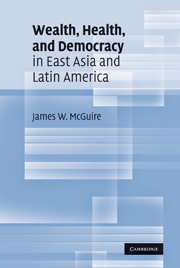Book contents
- Frontmatter
- Contents
- Figures and Tables
- Preface and Acknowledgments
- Abbreviations
- 1 Incomes, Capabilities, and Mortality Decline
- 2 Democracy, Spending, Services, and Survival
- 3 Costa Rica: A Healthy Democracy
- 4 Chile: The Pinochet Paradox
- 5 Argentina: Big Welfare State, Slow Infant Mortality Decline
- 6 Brazil: From Laggard to Leader in Basic Health Service Provision
- 7 Taiwan: From Poor but Healthy to Wealthy and Healthy
- 8 South Korea: Small Welfare State, Fast Infant Mortality Decline
- 9 Thailand: Democratization Speeds Infant Mortality Decline
- 10 Indonesia: Authoritarianism Slows Infant Mortality Decline
- 11 Wealth, Health, Democracy, and Mortality
- Appendix Tables
- Works Cited
- Index
6 - Brazil: From Laggard to Leader in Basic Health Service Provision
Published online by Cambridge University Press: 06 July 2010
- Frontmatter
- Contents
- Figures and Tables
- Preface and Acknowledgments
- Abbreviations
- 1 Incomes, Capabilities, and Mortality Decline
- 2 Democracy, Spending, Services, and Survival
- 3 Costa Rica: A Healthy Democracy
- 4 Chile: The Pinochet Paradox
- 5 Argentina: Big Welfare State, Slow Infant Mortality Decline
- 6 Brazil: From Laggard to Leader in Basic Health Service Provision
- 7 Taiwan: From Poor but Healthy to Wealthy and Healthy
- 8 South Korea: Small Welfare State, Fast Infant Mortality Decline
- 9 Thailand: Democratization Speeds Infant Mortality Decline
- 10 Indonesia: Authoritarianism Slows Infant Mortality Decline
- 11 Wealth, Health, Democracy, and Mortality
- Appendix Tables
- Works Cited
- Index
Summary
From 1960 to 2005 Brazil recorded faster economic growth, but slower infant mortality decline, than Chile or Costa Rica. Brazil's high income inequality helps to explain this disappointing performance, but government neglect of basic social service provision was also important. Such neglect can be traced partly to characteristics of the political regime that prevailed in Brazil for most of the second half of the twentieth century. From 1945 to 1964 Brazil was at best semi-democratic; voting was restricted by a literacy requirement and electoral competition was constrained by a ban on the Communist Party. From 1964 to 1985 the military ruled, although party, electoral, and legislative activity was not entirely shut down. From 1985 to 1990 the regime was again semi-democratic, with a civilian government elected indirectly by a rigged electoral college and subjected to intense military tutelage. Throughout these years, successive Brazilian governments fulfilled their obligations to “the people” partly by expanding the coverage of contributory health insurance, whereby Brazilians who earned a paycheck had a share of their pay deducted as a mandatory contribution to a health insurance fund that paid (usually) private providers for curative health services on a fee-for-service basis. Like Argentina, Brazil from the 1940s until the mid-1990s had a large welfare state (as measured by social spending and by health and old age insurance coverage), but was unsuccessful at providing basic social services to the least advantaged.
- Type
- Chapter
- Information
- Wealth, Health, and Democracy in East Asia and Latin America , pp. 149 - 180Publisher: Cambridge University PressPrint publication year: 2010



